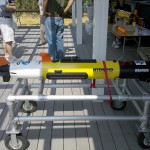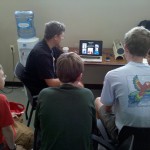While I was at the BEST workshop, I had an opportunity to talk with Tony about H.A.S.S. – the Hydronalix Autonomous Science & Security Boat. You may have heard of the Hydronalix for another product that Popular Science did a write-up on recently – E.M.I.L.Y. – which stands for “EMergency Integrated Lifesaving lanYard” (see Robo-Baywatch article).
HASS is a small hydro-jet powered boat a tad over 4 feet long. Its claim to fame is that it has the ability to approach marine mammals at a much closer proximity than is allowed via standard surface ships and that it will have much less of an impact with its presence due to its small size and electric drive. I shot a video with Tony (my apologies for the poor sound quality – lots of background noise).
HASS has an impressive list of features and capabilities which include:
- Hydro-jet powered to prevent damage to marine animals from a propeller
- Remotely Operated Camera
- Side-scanning Sonar
- Electric powered (batteries can be changed in ~5 minutes)
- Up to 40 mph speed, with 20-30 typical
- Endurance from 2-7 hours depending on operating conditions
- Wireless control via a nearby ship (~0.5 mile range) or support for control via iridium satellite phone
Doug


